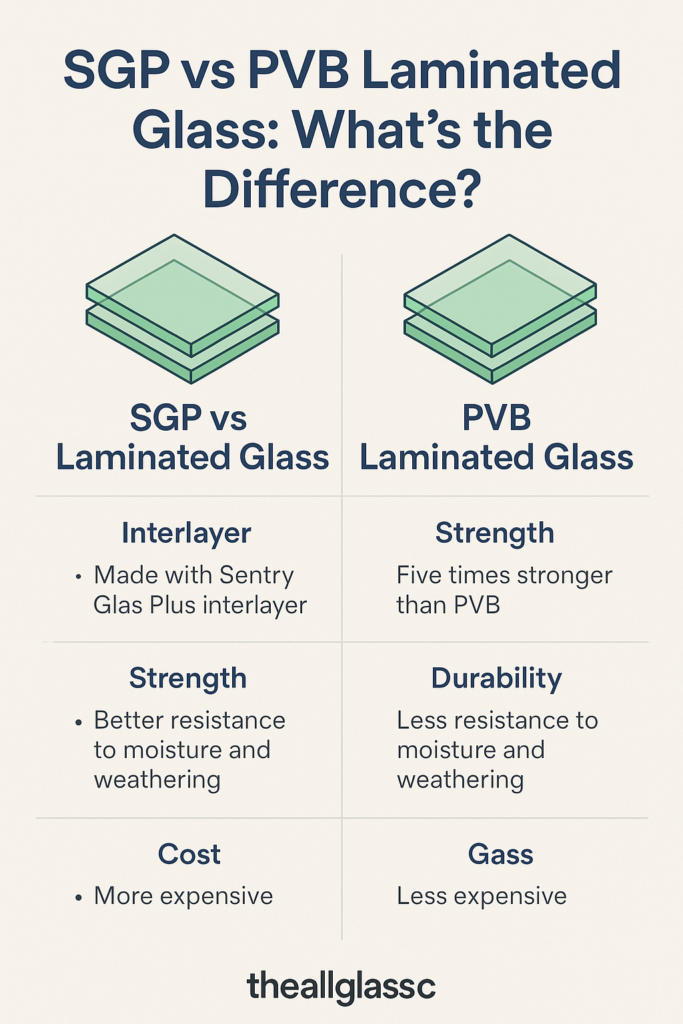In modern building design, laminated glass plays a crucial role in safety, aesthetics, and performance. But not all laminated glass is created equal. Two of the most widely used interlayers in laminated glass are PVB (polyvinyl butyral) and SGP (SentryGlas Plus). While both enhance security and impact resistance, they differ significantly in structural strength, clarity, moisture performance, and long-term durability. This article dives into the technical and architectural differences between SGP laminated glass and PVB laminated glass to help you choose the best fit for your project.
What Is Laminated Glass?
Laminated glass is a safety glazing material made by bonding two or more layers of glass with an interlayer. This interlayer keeps the glass intact if broken, preventing shards from scattering. Laminated glass is used in windows, facades, balustrades, skylights, and partitions for its security, sound insulation, and UV resistance.
The performance of laminated glass heavily depends on the type of interlayer used—typically either PVB or SGP.
What Is SGP Laminated Glass?
SGP laminated glass uses an ionoplast interlayer developed by Kuraray. Compared to traditional PVB, SGP is:
- 5 times stronger
- 100 times stiffer
- More resistant to moisture and UV exposure
- More stable in edge-exposed applications
Its stiffness and clarity make it ideal for structural applications where minimal framing, open-edge glass, and high weather loads are required.
What Is PVB Laminated Glass?
PVB laminated glass has been the industry standard for decades. It is known for:
- Good optical quality
- Strong adhesion between glass layers
- Acoustic insulation
- Affordable pricing
However, PVB is softer and more prone to edge delamination in moist or outdoor environments unless properly sealed. It remains widely used for general applications where high structural performance isn’t a priority.
Key Differences Between SGP and PVB Laminated Glass
1. Structural Strength and Load Bearing
| Feature | SGP Laminated Glass | PVB Laminated Glass |
|---|---|---|
| Tensile Strength | High | Medium |
| Post-Breakage Support | Maintains structure | Glass may sag or detach |
| Deflection | Minimal under load | Higher flexing |
SGP laminated glass in architecture is preferred for:
- Frameless balustrades
- Hurricane-resistant glazing
- Glass canopies and roofs
2. Moisture and UV Resistance
PVB can absorb moisture over time, leading to:
- Foggy edges
- Delamination
- Yellowing under UV exposure
SGP, being hydrophobic and UV-stable, resists:
- Salt spray
- Acid rain
- Humid environments
This makes SGP ideal for:
- Coastal areas
- Swimming pool fencing
- Exterior exposed glazing
3. Edge Clarity and Aesthetics
Because SGP has better edge stability and less moisture absorption, its exposed edges stay:
- Clear
- Smooth
- Visually appealing over time
This is especially important in:
- Frameless railings
- Transparent partition systems
- Floor-to-ceiling windows
PVB, in contrast, requires capping or sealing for long-term clarity.
4. Acoustic and Energy Efficiency
PVB offers superior sound insulation and is often used with acoustic-enhanced interlayers.
SGP, while stiffer, is less effective in blocking low-frequency noise unless combined with additional sound-dampening layers.
For energy performance, both types can be combined with:
- Low-E coatings
- IGU (insulated glazing units)
- Solar control films
🔗 How Laminated Glass Improves Energy Efficiency
5. Price Comparison
| Feature | SGP Laminated Glass | PVB Laminated Glass |
|---|---|---|
| Material Cost (per m²) | $100–$180+ | $35–$80 |
| Installation Cost | Higher (more structural) | Lower |
| Lifespan | 30–50 years | 15–30 years |
While SGP laminated glass price is higher, it offers better durability and fewer long-term maintenance costs.
SGP Laminated Glass Installation and Maintenance
Installation
- Requires precise fabrication and framing
- Suitable for structural glazing and overhead systems
- Edge protection is optional, depending on application
Care and Maintenance
- Clean with soft cloth and pH-neutral cleaners
- Inspect edges periodically
- Keep drainage systems clear
SGP laminated glass maintenance is minimal, making it ideal for difficult-to-access installations.
Which Laminated Glass Should You Choose?
| Application Type | Best Interlayer |
|---|---|
| Interior partitions | PVB |
| Balcony railings | SGP |
| Overhead glazing | SGP |
| Acoustic panels | PVB |
| Exterior curtain walls | SGP |
| Budget window projects | PVB |
If your project demands structural strength, clarity, and long-term weather resistance, go with SGP laminated glass. For cost-sensitive, non-structural indoor applications, PVB is a practical solution.
Conclusion
Choosing between SGP and PVB laminated glass comes down to understanding the performance requirements of your space. For structural, high-impact, or outdoor use, SGP laminated glass provides superior strength, stability, and lifespan. For standard applications, PVB still offers cost-effective safety and noise control.
Always consult experienced sgp laminated glass manufacturers to ensure you’re choosing the best system for your project’s needs.
Want a deeper dive into structural performance?
🔗 SGP Laminated Glass
🔗 Laminated Glass Lifespan
🔗 How Laminated Glass Improves Energy Efficiency

